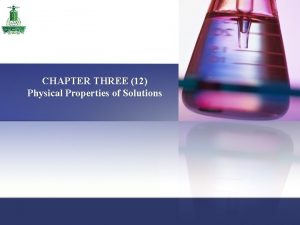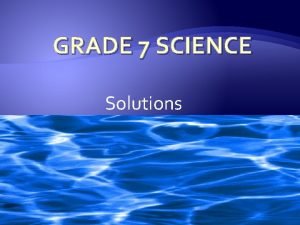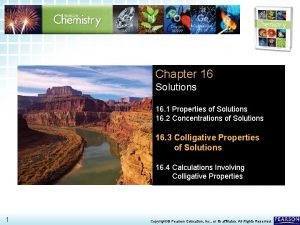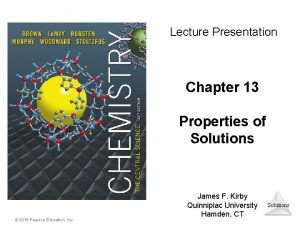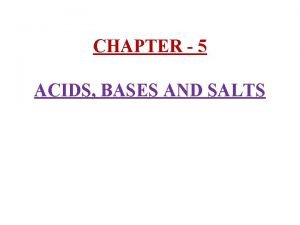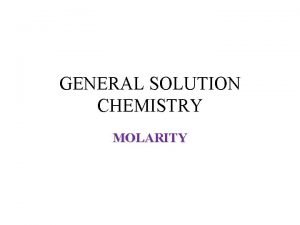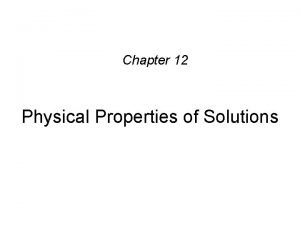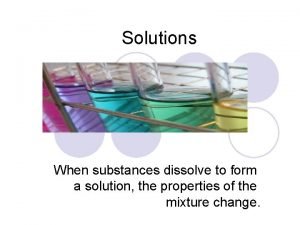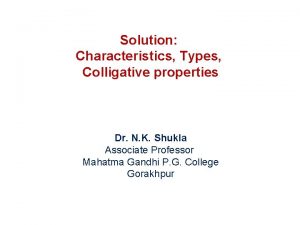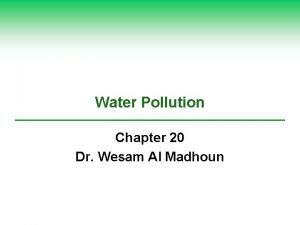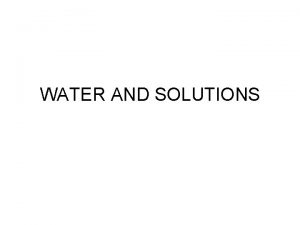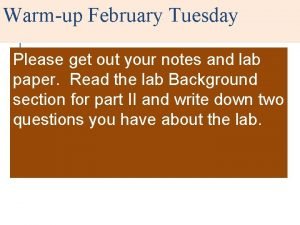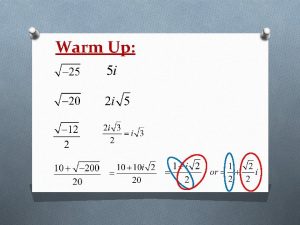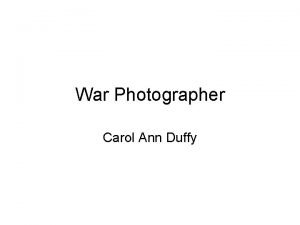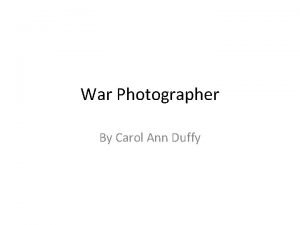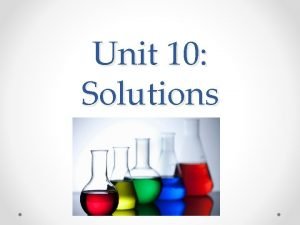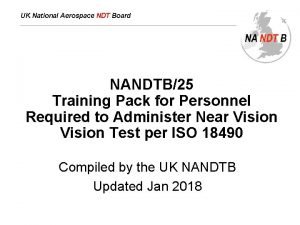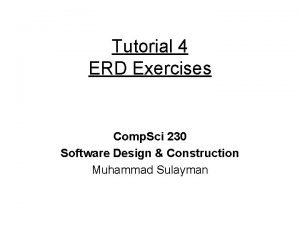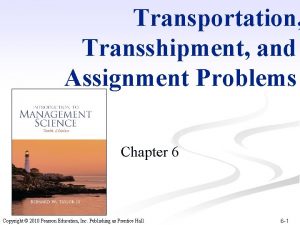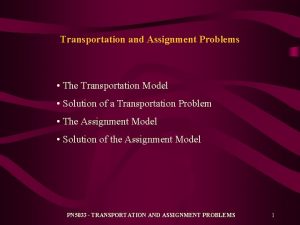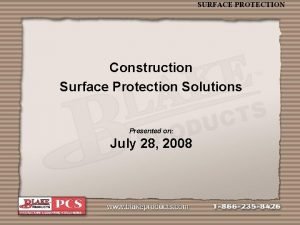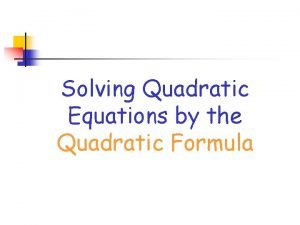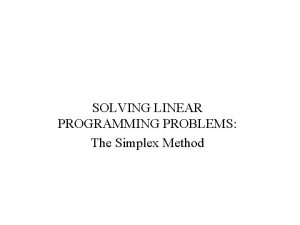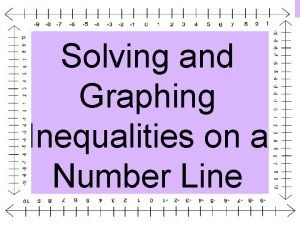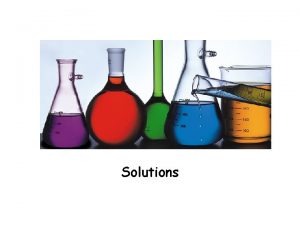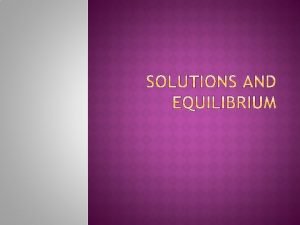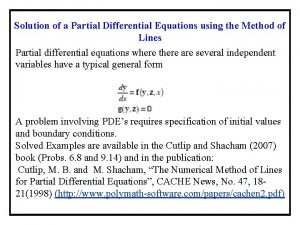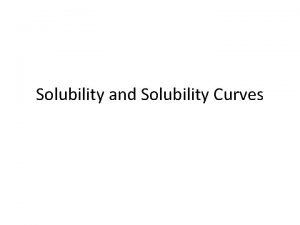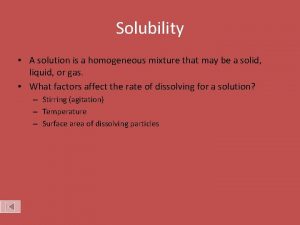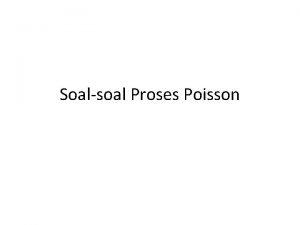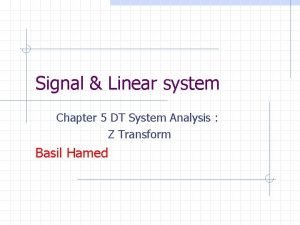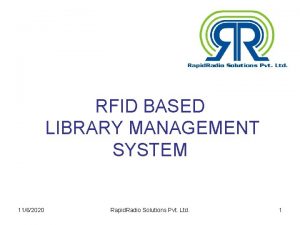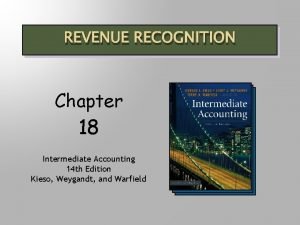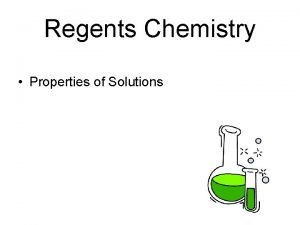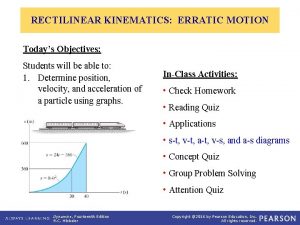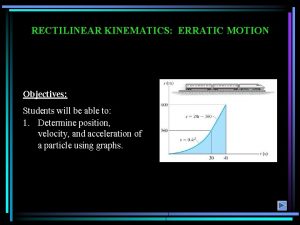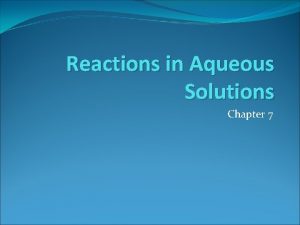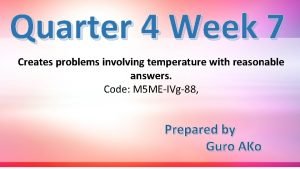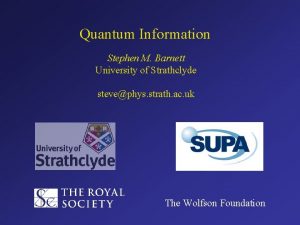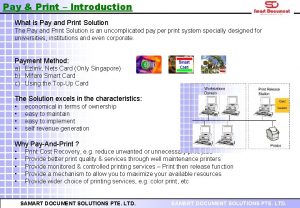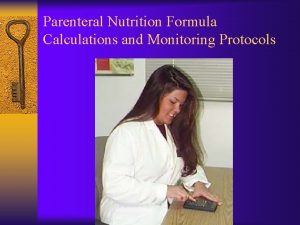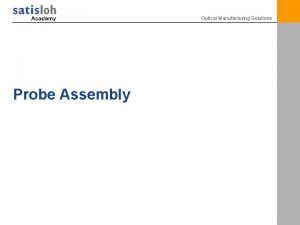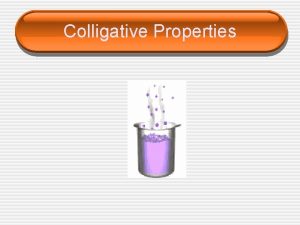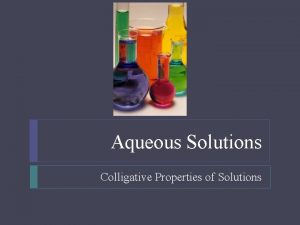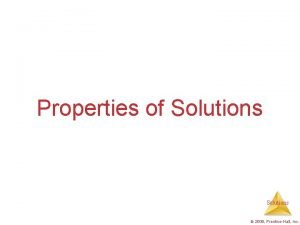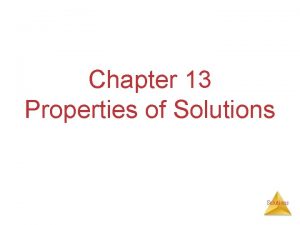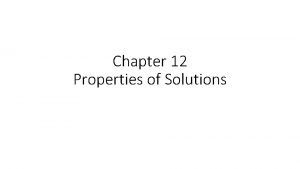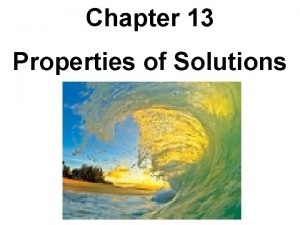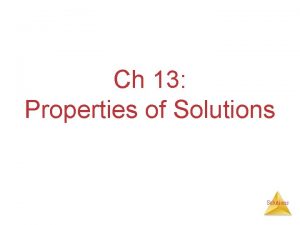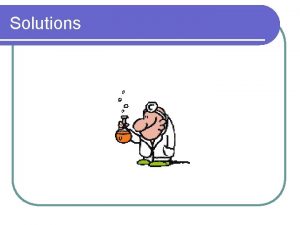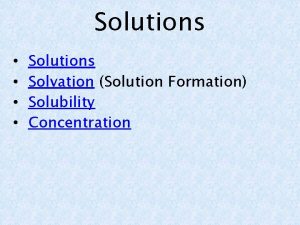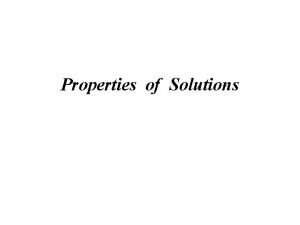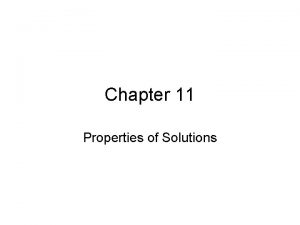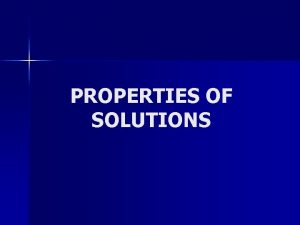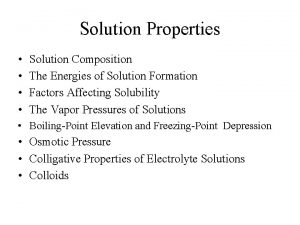Properties of Solutions A Solution l A solution




































































































- Slides: 100

Properties of Solutions

A Solution l. A solution is made up of a solute and a solvent. l The solvent does the dissolving. l The solute is the substance that is dissolved. Draw Picture: Ex. Salt Water Solution Salt=Solute Water=Solvent

A Solution l If a solution is made of two liquids, the one in lesser quantity is the solute.

The Universal Solvent l Water is the universal solvent. is a versatile solvent because of its attraction to other molecules and its polarity.

Water

Solutions l Solutions are homogeneous mixtures in a single phase (either solid, liquid or gas).

Solutions l Salt water, apple juice and dust free air (mixture of nitrogen, oxygen, argon, carbon dioxide, water vapor and other gases) are examples of homogeneous mixtures.

Solutions l Brass (solid mixture of copper and zinc) is also a homogeneous mixture. l Brass is an alloy, which is a mixture of metals.

Solutions l Oil and vinegar salad dressing is NOT a solution.

Solutions l Ice water is NOT a solution. Why? ?

Salt Solutions l Table salt (Na. Cl), like a great many ionic compounds, is soluble in water. l The salt solution is also an excellent conductor of electricity (an electrolye).

Salt Solutions l Free ions (such as Na+1 and Cl-1) in the solution are able to conduct the electricity and make the light bulb burn brightly.

Salt Solutions

Dissociation l When a salt dissolves (dissociates) in water, the cation (positive ion) of the salt is attracted to the oxygen ion (negative ion) of the water.

Dissociation l The anion (negative ion) of the salt is attracted to the hydrogen ion (positive ion) of the water.

Other Solutions l Water is not only good at dissolving ionic substances. It also is a good solvent for many covalent compounds. l Consider the covalent substance sucrose, commonly known as table sugar, as an example.

Other Solutions l When sugar dissolves in water, there are no free ions to conduct electricity. l The resulting solution is a nonelectrolyte, so the light bulb does NOT light up.

Making Solutions l. A if soluble substance dissolves faster it is stirred or shaken, Ø the particles are made smaller, and Ø the temperature is increased. Ø

Making Solutions l In order to dissolve the solvent molecules must come in contact with the solute. l Stirring moves fresh solvent next to the solute. l The solvent touches the surface of the solute. l Smaller pieces increase the amount of surface of the solute.

Temperature and Solutions l For solids in liquids, as the temperature goes up the solubility goes up. l A higher temperature makes the molecules of the solvent move around faster and contact the solute harder and more often.

Temperature and Solutions l It speeds up dissolving. l Higher temperature usually increases the amount that will dissolve.

1) How many grams of sodium hydroxide (Na. OH) will dissolve in 100 g of water at 15ºC? (100 g)

2) How many grams of sodium hydroxide will dissolve in 100 g of (140 g) water at 40ºC?

3) At what temperature will 90 grams of Pb(NO 3)2 dissolve in 100 g of water? (~50°C)

4) At what temperature will 30 grams of KNO 3 dissolve in 100 g of water? (20°C)

l For gases in a liquid, as the temperature goes up the solubility goes down. Ex. Sodas at the gas station

l For gases in a liquid, as the pressure goes up the solubility goes up.

Colligative Properties

Vapor Pressure Lowering l Vapor Pressure is the pressure exerted by a gas on a liquid (pressure caused by gas due to liquid evaporating) l The bonds between molecules keep molecules of a liquid from escaping into the vapor state. l In a solution, some of the solvent is busy keeping the solute dissolved. l This lowers the vapor pressure.

Vapor Pressure Lowering l The greater the number of ions, the more a salt will lower the vapor pressure. l Na. Cl ® Na+ + Cl- l Ca. Cl 2 2 ions ® Ca+2 + 2 Cl- l Calcium 3 ions chloride would lower the vapor pressure more because it dissociates into more ions.

Boiling Point Elevation l The vapor pressure determines the boiling point. l When vapor pressure is lower, the boiling point is higher. l It turns out that the boiling point of a solution is higher than the boiling point of the pure solvent. Ex. Plain water vs. Salt Water

Boiling Point Elevation l Salt water boils above 100ºC. l KBr ® K+ + Br- l Mg. F 2 2 ions ® Mg+2 + 2 F- l Magnesium 3 ions fluoride would raise the boiling point more because it dissociates into more ions.

Freezing Point Depression l Solids form when molecules make an orderly pattern. l The solute molecules, i. e. salt, break up the orderly pattern. l This l Ex. makes the freezing point lower. Salt on roads in Winter

Freezing Point Depression l Salt water freezes below 0ºC. l K 2 SO 4 l Na. Cl ® 2 K+ + SO 4 -2 ® Na+1 + Cl- l Potassium 3 ions 2 ions sulfate would lower the freezing point more because it dissociates into more ions.

Osmotic Pressure Increase l Osmotic pressure is the force with which a pure solvent moves across a semi-permeable barrier into a container that holds a solution l The bigger the difference in concentration (because of high solute concentration), the stronger the force of osmosis.

Osmotic Pressure Increase


Measuring Solutions

Concentration l Chemists never apply the terms strong and weak to solution concentrations. l Instead, use the terms concentrated and dilute.

Concentration l Concentration is a measure of the amount of solute dissolved in a certain amount of solvent. l A concentrated solution has a large amount of solute. l A dilute solution has a small amount of solute.

Molarity l For chemistry applications, the concentration term molarity is generally the most useful. l Molarity is the number of moles of solute in 1 Liter of the solution. M= moles of solute liter of solution

Example l What is the molarity of a solution with 2. 0 moles of Na. Cl in 4. 0 Liters of solution? M = 2. 0 moles mol 4. 0 liters L M = 0. 50 M

Problem 1) What is the molarity of a solution with 3. 0 moles dissolved in 250 m. L of solution? M = 3. 0 moles mol liters 0. 25 L M = 12 M

Problem 2) How many moles of Na. Cl are needed to make 6. 0 L of a 0. 75 M Na. Cl solution? 0. 75 M M == moles liters 6. 0 L moles = 4. 5 moles

Problem 3) 0. 200 moles of Na. OH are dissolved in a small amount of water then diluted to 500. m. L. What is the concentration? (0. 400 M)

Problem 4) 1. 25 moles of Na. Cl are dissolved in a small amount of water then diluted to 625 m. L. What is the concentration? (2. 00 M)

Problem 5) How many moles are in 2. 00 L of a 3. 00 M solution of sulfuric acid (H 2 SO 4)? (6. 00 mol)

Problem 6) How many moles are in 1500 m. L of a 3. 2 M solution of nitric acid (HNO 3)? (4. 8 mol)

Example l 10. 3 g of Na. Cl are dissolved in a small amount of water then diluted to 250 m. L. What is the concentration? l Na. Cl – Sodium: 23. 0 g – Chlorine: 35. 5 g 58. 5 g

Example, cont l 10. 3 g of Na. Cl are dissolved in a small amount of water then diluted to 250 m. L. What is the concentration? 10. 3 g 1 mol 58. 5 g = 0. 176 mol

Example, cont. l 10. 3 g of Na. Cl are dissolved in a small amount of water then diluted to 250 m. L. What is the concentration? M = 0. 176 moles mol 0. 25 liters. L M = 0. 70 M

Problem 7) 20. 3 g of Na. OH are dissolved in a small amount of water then diluted to 500. m. L. What is the concentration? (1. 02 M)

Problem 8) 80. 6 g of KCl are dissolved in a small amount of water then diluted to 500. m. L. What is the concentration? (2. 16 M)

Problem 9) 125 g of Na. C 2 H 3 O 2 are dissolved in a small amount of water then diluted to 750. m. L. What is the concentration? (2. 03 M)

Example l How many grams of Ca. Cl 2 are needed to make 625 m. L of a 2. 00 M solution? 2. 0 M == moles 0. 625 liters L moles = 1. 25 moles

Example, cont. l How many grams of Ca. Cl 2 are needed to make 625 m. L of a 2. 00 M solution? 1. 25 mol 111. 1 g = 139 g 1 mol 139 g of calcium chloride is added to enough distilled water to make a total volume of 625 m. L.

Problem 10) How many grams of sugar are needed to make 125 m. L of a 0. 500 M C 6 H 12 O 6 solution? (11. 3 g)

Problem 11) How many grams of sodium hydroxide are needed to make 500. m. L of a 0. 750 M Na. OH solution? (15. 0 g)

Problem 12) How many grams of aluminum nitrate are needed to make 600. m. L of a 0. 500 M Al(NO 3)2 solution? (45. 3 g)


Dilution Adding Water to a Solution

Dilution l The number of moles of solute doesn’t change if you add more solvent. M 1 x V 1 = M 2 x V 2 l M 1 and V 1 represent the starting concentration and volume. l M 2 and V 2 represent the final concentration and volume.

Example l 2. 0 L of a 0. 88 M solution are diluted to 3. 8 L. What is the new molarity? 0. 88 M 1 (2. 0) V 1 = M 2 3. 8 V 2 M 2 = 0. 46 M

Problem 13) 6. 0 L of a 0. 55 M solution are diluted to 8. 8 L. What is the new molarity? (M 2 = 0. 38 M)

Problem 14) You have 150 m. L of 6. 0 M HCl. What volume of 1. 3 M HCl can you make? 6. 0 M 1(150) V 1 = M 1. 3 2 V 2 = 692 m. L

Problem 15) 6. 0 liters of a 0. 55 M solution are diluted to a 0. 35 M solution. What is the final volume? (V 2 = 9. 4 L)

Problem 16) You need 450 m. L of 0. 15 M Na. OH. All you have available is a 2. 0 M stock solution of Na. OH. How do you make the required solution? 0. 15 M 1(450) V 1 = M 2. 0 2 V 2 = 34 m. L

Problem l You need 450 m. L of 0. 15 M Na. OH. All you have available is a 2. 0 M stock solution of Na. OH. How do you make the required solution? You should take 34 m. L of the 2. 0 M Na. OH and add (450 – 34) m. L = 416 m. L of distilled water to the solution.

How Much Solute? l Solubility is the maximum amount of substance that will dissolve at that temperature (usually measured in grams/liter).

How Much Solute? l If the amount of solute dissolved is less than the maximum that could be dissolved, the solution is called an unsaturated solution.

How Much Solute? l. A solution which holds the maximum amount of solute per amount of the solution under the given conditions is called a saturated solution.

How Much Solute? l. A supersaturated solution contains more solute than the usual maximum amount and is unstable.

How Much Solute? l. A supersaturated solution cannot permanently hold the excess solute in solution and may release it suddenly. l. A seed crystal will make the extra come out.

How Much? l Generally, a supersaturated solution is formed by dissolving a solute in the solution at an elevated temperature, at which solubility is higher than at room temperature, and then slowly cooling the solution.

Degree of Saturation

a) If 45 g of KCl is dissolved in 100 g of water at 60ºC, is the solution unsaturated, saturated or supersaturated? (saturated)

b) If 90 g of Pb(NO 3)2 is dissolved in 100 g of water at 40ºC, is the solution unsaturated, saturated or supersaturated? (supersaturated)

c) If 30 g of KNO 3 is dissolved in 100 g of water at 20ºC, is the solution unsaturated, saturated or supersaturated? (saturated)

d) If 10 g of KCl. O 3 is dissolved in 100 g of water at 50ºC, is the solution unsaturated, saturated or supersaturated? (unsaturated)

Compounds in Aqueous Solution l The separation of ions when an ionic compound dissolves in water is called dissociation. l Although no compound is completely insoluble, compounds of very low solubility can be considered insoluble.

Compounds in Aqueous Solution l Using the solubility rules printed on page 6 of the NCDPI Reference Tables for Chemistry, determine whether the following salts are soluble in water. a) sodium chloride (soluble)

Compounds in Aqueous Solution b) mercury (I) acetate (soluble) c) potassium nitrate (soluble)

Compounds in Aqueous Solution d) nickel carbonate (insoluble) e) barium sulfate (insoluble)

Compounds in Aqueous Solution f) ammonium bromide (soluble) g) calcium sulfide (soluble)

Double Replacement Reactions l In a double-replacement reaction, two compounds exchange partners with each other to produce two different compounds. The general form of the equation is l AB + CD → AD + CB

Double Replacement Reactions l Signs that a double-replacement reaction has taken place include a color change, the release or absorption of energy, evolution of a gas, and formation of a precipitate (which is a solid that will not dissolve in water).

Net Ionic Equations l In molecular equations, the formulas of the compounds are written as though all species existed as molecules or whole units.

Net Ionic Equations l An ionic equation shows dissolved ionic compounds in terms of their free ions.

Net Ionic Equations l Ions that are not involved in the overall reaction are called spectator ions. l The net ionic equation indicates only the species that actually take part in the reaction.

Net Ionic Equations The following steps are useful for writing ionic and net ionic equations: 1) Write a balanced molecular equation for the reaction.

Net Ionic Equations 2) Rewrite the equation to indicate which substances are in ionic form in solution. Remember that all soluble salts (and other strong electrolytes), are completely dissociated into cations and anions. This procedure gives us the ionic equation.

Net Ionic Equations 3) Lastly, identify and cancel spectator ions on both sides of the equation to arrive at the net ionic equation.

Molecular equation: 3 Na. OH + Fe. Cl 3 Fe(OH)3 + 3 Na. Cl Complete ionic equation: 3 Na+ + 3 OH- + Fe 3+ + 3 Cl- Fe(OH)3 + 3 Na+ + 3 Cl. Net ionic equation: 3 OH- (aq) + Fe 3+ (aq) Fe(OH)3 (s)

Example l Identify the spectator ions and the precipitate and write the balanced net ionic equation. (NH 4)2 SO 4 + Ba. F 2 ________ The products are Ba. SO 4 and NH 4 F. Which product is insoluble?

Example l Identify the spectator ions and the precipitate and write the balanced net ionic equation. (NH 4)2 SO 4 + Ba. F 2 ________ Ba. SO 4 is the precipitate. NH 4+ and F- are the spectator ions. Ba 2+ + SO 42 - Ba. SO 4

Double Replacement Reactions l Identify the spectator ions and the precipitate and write the balanced net ionic equation. a) Ba. Cl 2+ Ag. NO 3 → Ag. Cl is the precipitate. Ba 2+ and NO 3 - are spectator ions. Ag+ + Cl- Ag. Cl

Double Replacement Reactions b) Pb(NO 3)2 + KI → Pb. I 2 is the precipitate. NO 3 - and K+ are the spectator ions. Pb 2+ + 2 I- Pb. I 2

Double Replacement Reactions c) (NH 4)2 SO 4+ Ba(NO 3)2 → Ba. SO 4 is the precipitate. NH 4+ and NO 3 - are the spectator ions. Ba 2+ + SO 42 - Ba. SO 4

Double Replacement Reactions d) K 2 S+ Zn(C 2 H 3 O 2)2 → Zn. S is the precipitate. K+ and C 2 H 3 O 2 - are the spectator ions. Zn 2+ + S 2 - Zn. S

Double Replacement Reactions e) Sr 3(PO 4)2+ Al(OH)3 → Al. PO 4 is the precipitate. Sr 2+ and OH- are the spectator ions. Al 3+ + PO 43 - Al. PO 4
 Reocentral
Reocentral Physical properties of solutions
Physical properties of solutions What is solvent in science grade 7
What is solvent in science grade 7 Freezing point chapter 13
Freezing point chapter 13 Which solution
Which solution General properties of aqueous solutions
General properties of aqueous solutions Visitor management solutions for properties
Visitor management solutions for properties Physical properties of solutions
Physical properties of solutions Chapter 13 properties of solutions
Chapter 13 properties of solutions Intensive and extensive properties
Intensive and extensive properties Physical properties and chemical properties
Physical properties and chemical properties Lemon juice effect on turmeric solution and remarks
Lemon juice effect on turmeric solution and remarks Chemistry
Chemistry Non colligative properties
Non colligative properties Physical properties of solution
Physical properties of solution Physical properties of solution
Physical properties of solution Properties of solution
Properties of solution Properties of solution
Properties of solution Vapour pressure
Vapour pressure Classroom lockdown solutions
Classroom lockdown solutions World bank survey solutions
World bank survey solutions Cch fp solutions
Cch fp solutions Wealth advisory solutions
Wealth advisory solutions Solutions to water pollution
Solutions to water pollution Dilute and concentrated
Dilute and concentrated Saturated and unsaturated solutions worksheet
Saturated and unsaturated solutions worksheet Types of discriminant solutions
Types of discriminant solutions The only light is red and softly glows
The only light is red and softly glows Spools of suffering
Spools of suffering Ubs business solutions
Ubs business solutions Weak entity database
Weak entity database Molarity
Molarity Schneider unica switches
Schneider unica switches National aerospace solutions
National aerospace solutions Buyer initiated payments bip
Buyer initiated payments bip 4erd
4erd Trucker tax solutions
Trucker tax solutions Integrity billing solutions
Integrity billing solutions Transshipment problem examples and solutions excel
Transshipment problem examples and solutions excel Prohibited route in transportation problem means
Prohibited route in transportation problem means What kind of work does panchito's family do
What kind of work does panchito's family do Helen midtown computer solutions helen speaking
Helen midtown computer solutions helen speaking Surface protection solutions
Surface protection solutions Svm exercises
Svm exercises What is the ha
What is the ha Example of quadratic equation
Example of quadratic equation Simplex method
Simplex method Graphing inequalities on a number line
Graphing inequalities on a number line Limits and continuity problems with solutions
Limits and continuity problems with solutions Are solutions homogeneous
Are solutions homogeneous Are all solutions homogeneous mixtures
Are all solutions homogeneous mixtures Solutions for patient safety
Solutions for patient safety Pde solutions
Pde solutions Solid
Solid Saturated and unsaturated solutions worksheet
Saturated and unsaturated solutions worksheet The example of solid solution
The example of solid solution Contoh soal proses poisson
Contoh soal proses poisson Smart printing solutions ltd
Smart printing solutions ltd Summary of ratio analysis
Summary of ratio analysis Compounded daily
Compounded daily Compound interest vocabulary
Compound interest vocabulary Signals and systems oppenheim solutions chapter 5
Signals and systems oppenheim solutions chapter 5 Bluecielo ecm solutions b.v.
Bluecielo ecm solutions b.v. Tally solutions pvt ltd
Tally solutions pvt ltd Market overview managed file transfer solutions
Market overview managed file transfer solutions Searching for solutions in artificial intelligence
Searching for solutions in artificial intelligence Rudra environmental solution
Rudra environmental solution Risk based solutions
Risk based solutions Turnkey compliance solutions
Turnkey compliance solutions Man energy solutions berlin
Man energy solutions berlin Rapid radio solutions
Rapid radio solutions Chapter 18 revenue recognition kieso
Chapter 18 revenue recognition kieso Ibm retail solutions
Ibm retail solutions Parallel force
Parallel force Residual income valuation model
Residual income valuation model Live sports broadcast solutions
Live sports broadcast solutions Solutions chemistry regents questions
Solutions chemistry regents questions Rectilinear kinematics
Rectilinear kinematics Erratic motion problems with solutions
Erratic motion problems with solutions Real life examples of multiplication
Real life examples of multiplication Reactions in aqueous solutions
Reactions in aqueous solutions Balancing aqueous solutions
Balancing aqueous solutions Quick software solutions
Quick software solutions Problem solving involving temperature
Problem solving involving temperature Grover's algorithm multiple solutions
Grover's algorithm multiple solutions Quantum information stephen m. barnett
Quantum information stephen m. barnett Goodyear proactive solutions
Goodyear proactive solutions Crpytocoin
Crpytocoin Cbc1501 essay writing
Cbc1501 essay writing Solutions for poverty
Solutions for poverty Pollution causes effects and solutions
Pollution causes effects and solutions Seorang siswa akan
Seorang siswa akan Pay to print
Pay to print Tpn calculations
Tpn calculations Panasonic digital signage
Panasonic digital signage Dave moore highwater site: linkedin.com
Dave moore highwater site: linkedin.com Sybase ebiz impact
Sybase ebiz impact Optical manufacturing solutions
Optical manufacturing solutions Grand solutions international
Grand solutions international Oiwa solutions
Oiwa solutions Operations management chapter 3 solutions
Operations management chapter 3 solutions

